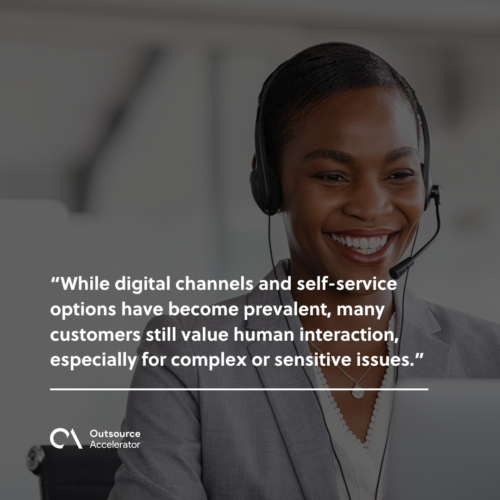5 Customer service myths that could be costing you customers

Customer expectations continue to shift, and businesses must keep their customer service practices current to stay competitive. Relying on outdated methods can lead to frustration, missed opportunities, and lost loyalty.
More so, many teams unknowingly follow outdated beliefs that no longer reflect how customers think or behave. These false notions can create gaps in communication, slow response times, and lead to poor experiences.
Misconceptions about what customers want or how they interact with support can hold teams back from making meaningful improvements.
In this article, we’ll break down five common customer service myths that often lead teams in the wrong direction, and explain how to adjust practices to meet the needs of today’s diverse clientele.
Traditional vs. modern customer service
Customer service has changed significantly over the years. Businesses that once relied on phone calls and face-to-face interactions now manage support across multiple digital channels.
While both traditional and modern methods aim to assist customers, the tools and expectations involved are very different. Understanding these changes helps teams stay relevant and respond more effectively.

Here’s a breakdown of key differences between traditional and modern customer service:
| Traditional customer service | Modern customer service |
| Phone and in-person support | Live chat, email, and social media |
| Limited service hours | 24/7 support options |
| Reactive problem-solving | Proactive customer engagement |
| One-size-fits-all solutions | Personalized experiences |
| Manual tracking and logging | Data-driven tools and automation |
| Longer response times | Real-time or near-instant replies |
Modern customer service focuses on flexibility, speed, and personalization. It values customer feedback, uses technology to improve communication, and adapts to different preferences.
Businesses that still rely on outdated methods may struggle to meet current expectations and lose their competitive edge.
This shift in approach also highlights the risk of following long-standing but outdated beliefs. Many teams still operate based on assumptions that no longer apply.
In the next section, we’ll explore five common customer service myths that can hold businesses back, and what to do instead.
5 customer service myths that can be harming your business
Customer service is a critical component of business success. However, many organizations operate under misconceptions that can negatively impact customer satisfaction and loyalty.
According to a report by the Institute of Customer Service, consumer satisfaction in the UK has declined. Many sectors are experiencing rising dissatisfaction due to outdated service models and economic pressures.
Here we have five customer service misconceptions that may be affecting your income generation:
1. The customer is always right
This traditional belief can lead to situations where employees feel compelled to agree with unreasonable customer demands, potentially compromising company policies and employee morale.
While it’s essential to value customer feedback, it’s equally important to set boundaries to protect staff and maintain service standards.
What to do instead: Empower your team to handle challenging situations with confidence. Provide training on conflict resolution and establish clear guidelines for acceptable customer behavior.
Encourage staff to assertively manage interactions while maintaining professionalism and respect.
2. Customers prefer self-service over human interaction
While digital channels and self-service options have become prevalent, many customers still value human interaction, especially for complex or sensitive issues. A recent survey found that out of 4,000 respondents, three-quarters prefer speaking to a live agent for assistance.
What to Do Instead: Offer a balanced approach by providing accessible self-service options alongside readily available human support. Ensure that customers can easily transition between channels without repeating information.

3. Customer complaints are a bad sign
Many businesses view customer complaints as negative feedback that needs to be avoided. However, complaints can serve as valuable insights into areas needing improvement. Ignoring or dismissing them may result in missed opportunities to enhance service quality.
What to Do Instead: Persuade customers to voice their concerns and view complaints as constructive criticism. Implement systems to track and analyze feedback, using it to drive continuous improvement.
4. More channels mean better service
Expanding service channels can increase accessibility, but it doesn’t automatically translate to better service. Without proper integration, multiple channels can lead to fragmented experiences and customer frustration.
What to Do Instead: Focus on quality over quantity. Make sure each channel is well-supported and that customer interactions are consistent and seamless across all platforms.
5. Customer service is a cost center
Some businesses view customer service as an expense rather than an investment. This mindset can lead to underfunding and undervaluing the department, potentially affecting service quality and customer satisfaction.
What to Do Instead: Recognize customer service as a strategic asset that contributes to customer retention and brand loyalty. Allocate resources to enhance training, tools, and support for your team.
Knowing and addressing these customer service myths is crucial for companies aiming to improve their service delivery and customer relationships.
Hire top-tier customer service representatives with SixEleven
Gain a competitive edge by partnering with professionals who understand your brand and prioritize customer satisfaction. Act now to connect with skilled representatives ready to boost your support experience and strengthen client loyalty.
Connect with SixEleven and discover how the right team can make all the difference—your customers deserve nothing less!







 Independent
Independent




